American Kestrel (Falco sparverius)
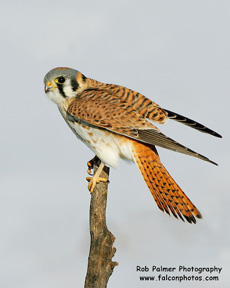
Description
- Rusty tail and back
- Females have rust colored wings, while males have slate-blue colored wings
- 15 sub-species.
Size
- Length: 9-12" (23-30 cm)
- Wingspan: 21" (.5 m)
Range
- Farmland, deserts, towns, cities, and open country
- Close to the tree line in Alaska and Canada, south to Tierra del Fuego
Diet
- Mostly insects and small rodents
- Occasionally, especially during winter, small songbirds such as sparrows and starlings
Voice
- "Klee-klee-klee-klee-klee-klee"
Nesting
- Natural or man-made crevices such as abandoned woodpecker nests and bird houses
- Lay 4-5 white eggs spotted brown
- Eggs incubate for 29-30 days tended by both parents
Merlin (Falco columbarius)
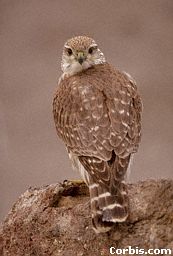
Description
- Slate or brown above, with a long banded tail, light and streaked below
- No moustache markings unlike the other falcons
Size
- Length: 10-14" (25-35 cm)
- Wingspan: 23" (.6 m)
Range
- Open woodlands and groves near coniferous forests
- Alaska, Labrador south to Nova Scotia, Michigan and Orego
- Winters in British Columbia and Newfoundland to Northern South America
Diet
- Small birds
- Occasionally, small rodents, insects and lizards
Voice
- Usually silent
- When nesting area is disturbed ,"Klee, Klee" similar to an American Kestrel
Nesting
- Nest made of sticks or tree cavity or abandoned nest 15-35 ft above ground
- Lay 4-5 pale rusty eggs with brown or purple spotting
- Eggs incubate for 28-32 days
- Fledgelings leave the nest at 25-30 days after hatching
Peregrine Falcon (Falco peregrinus)
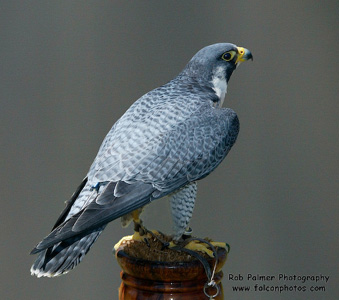
Description
- Slate gray above and pale below with fine black bars and spots
- Dominant black moustache markings
- Immature are brown and darker below
Size
- Length: 15-21" (38-53 cm)
- Wingspan: 40" (1 m)
Range
- Open country near water and in cities near buildings
- Alaska and Greenland south to Georgia and Baja California
- Winters north to British Columbia and Massachusetts
Diet
- Mainly birds
- Occasionally, rodents and insects
Voice
- "Kack-kack-kack"
- "Wee-chew, Wee-chew"
Nesting
- Nest is a scrape with little lining on cliffs or building ledges
- Lay 2-4 cream colored eggs with brown spots
- Eggs incubate for 28 days
- Fledgelings leave the nest at 5-6 weeks after hatching
Prairie Falcon (Falco mexicanus)
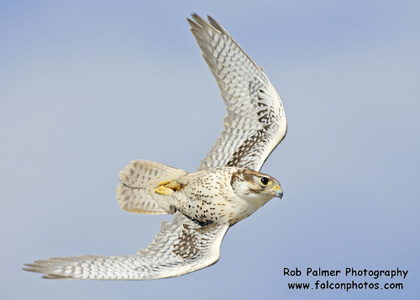
Description
- Sandy brown and faintly barred above, cream and lightly streaked and spotted below
- Dominant black moustache markings
- Dark wing markings when viewed flying
Size
Range
- Dry plains and desert cliffs
- Central British Columbia, northern Alberta and Saskatchewan and western North Dakota, south to Baja California, Mexico and to southern Arizona and New Mexico and northern Texas
- Winters in Mexico
Diet
- Small and medium-sized birds and mammals
- Occasionally. lizards and large insects
Voice
- "kik-kik-kik-kik-kik'"
- Whining "kruk"
Nesting
- Nest is a depression in soil or gravel, on a ledge, or in an abandoned nest of another
- Lay 3-6 pinkish eggs spotted with brown and purple
- Eggs incubate for 30 days
- Fledgelings leave the nest at 40 days after hatching
Gyrfalcon (Falco rusticolus)
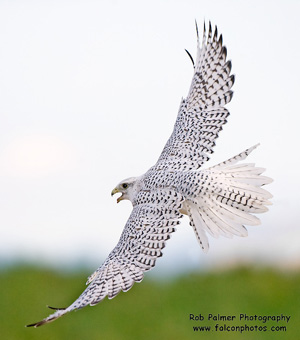
Description
- 3 color phases- white, black, and gray all streaked with black
- No moustache or head markings unlike the other falcons
Size
- Length: 22" (56 cm)
- Wingspan: 48-63" (1.2-1.6 m)
Range
- Arctic tundra and rock cliffs near water, coastal beaches and marshes
- Alaska, Canada, and Greenland south to central Canada and Northern U.S.
Diet
- Birds, especially arctic ptarmigan
- Occasionally, large ducks and geese
Voice
Nesting
- Rock ledge lined with sticks, grass, and moss
- Lay 4 heavily spotted reddish-brown eggs
- Eggs incubate for 4 weeks tended by the female
- Fledgelings leave the nest at 7 weeks after hatching
|